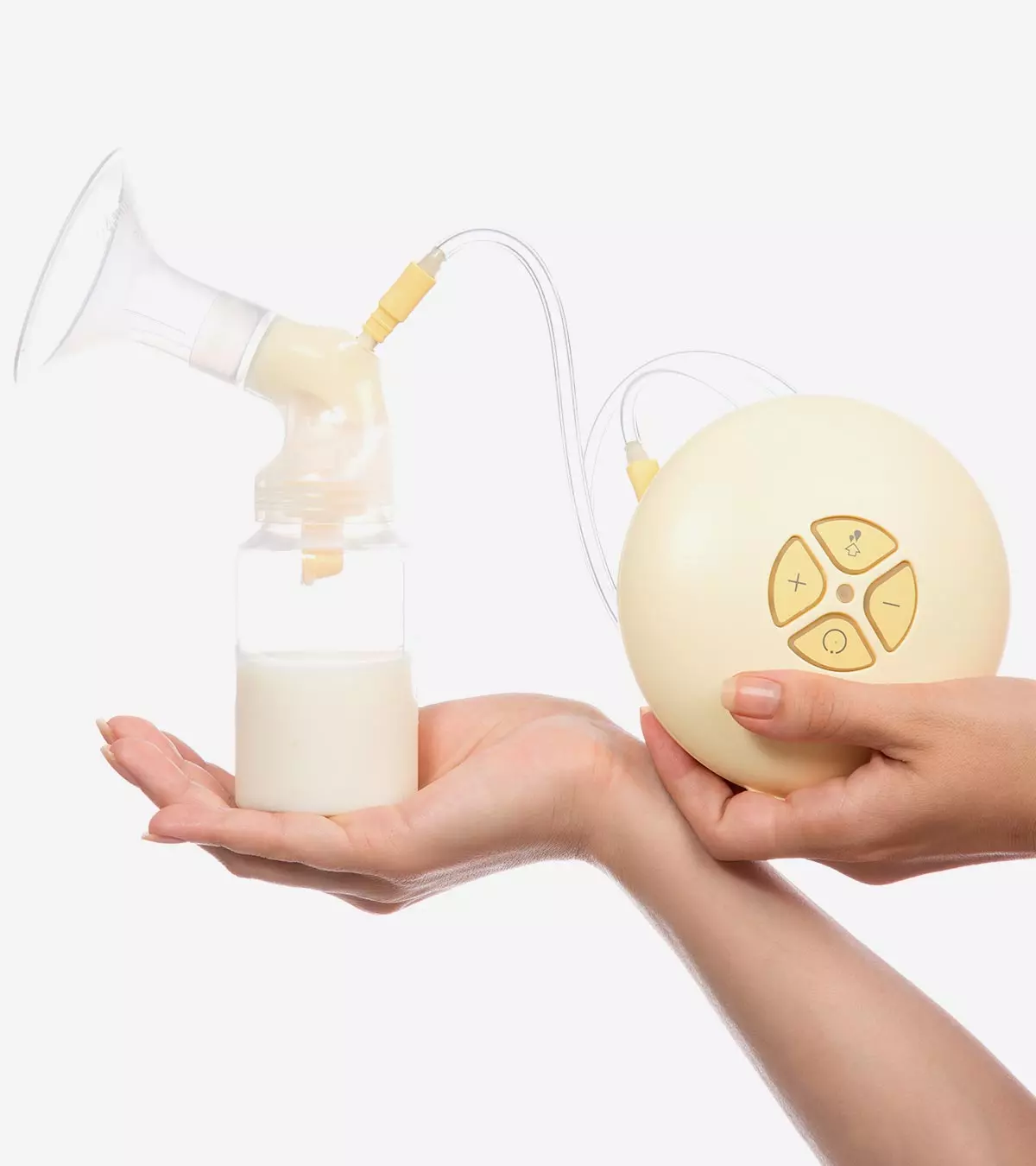

Image: Shutterstock
Croup in babies is a respiratory infection that affects the upper airways and causes them to swell. Swollen and irritated airways cause a hoarse voice, noisy breathing (stridor), and barking cough, making croup distinctive from a regular cough.

The characteristic cough sound can leave parents perplexed and worried. However, croup is a common infection that usually manifests mild symptoms. Most babies recover with simple home remedies and minimal medical intervention.
Read on to know more about the causes of croup in babies, including its common symptoms, diagnosis, treatment, and effective prevention measures.
What Is Croup In Babies?
Croup is a condition in which the larynx (voice box) and trachea (windpipe) develop acute inflammation. Croup is medically called laryngotracheobronchitis or laryngotracheitis (1).
The larynx houses the vocal cords, through which the air passes while breathing. An inflamed larynx constricts the vocal cords, causing the air to pass through a narrow opening. The contraction of the vocal cords causes a noise, makes breathing difficult for the baby, and leads to the unique “barking” cough associated with croup.
There are three types of croup. Keep reading to know what causes each of them.
What Causes Croup In Babies?
The following are the causes of croup in babies (2) (3):
1. Viral croup
Viruses are the leading cause of croup among infants. The viruses usually infect the upper respiratory system, such as the nose and upper airways, and slowly move down the respiratory system to affect the larynx and trachea, causing croup. Several viruses can be responsible for croup among infants:
- Parainfluenza virus is the leading cause of croup among babies and toddlers (4). The human parainfluenza virus (HPIV) has four types, and croup is among the several diseases caused by these viruses.
- Respiratory syncytial virus (RSV) causes mild, cold-like symptoms in adults but can be responsible for serious illnesses like bronchiolitis, pneumonia, and even croup in younger children and babies.
- The influenza virus is fundamentally responsible for flu, but can also cause croup in babies.
- Adenovirus is a group of several viruses that can cause croup, among other diseases (5).
- Enterovirus is also a group of viruses that primarily affect children, resulting in various illnesses, including croup (6).
2. Bacterial croup
Croup is usually one of the symptoms of a bacterial infection caused by (7) (8):
- Staphylococcus aureus
- Haemophilus influenzae
- Corynebacterium diphtheriae
- Streptococcus pneumoniae
3. Spasmodic croup (laryngismus stridulus)
Spasmodic croup occurs when another ailment triggers it. Common causes of spasmodic croup are respiratory allergies, asthma, and acid reflux. It is quite likely to occur when the infant is exposed to allergens, such as pollen and dust particles.
How Does A Baby Get Croup?
Your baby can get croup through the following ways:
- Exposure to the bacteria or virus: Viral and bacterial croup can be highly contagious. Babies can get croup if they come in close contact with an infected person, and touch a surface or an object contaminated with the pathogens. Sharing utensils with an infected person can also cause croup.
- Presence of allergies: If the baby has respiratory allergies or asthma, then he/she can be at a higher risk of developing spasmodic croup.
- Other problems: Complications such as gastroesophageal reflux disease (GERD) may make the baby prone to croup. Usually, the acid from the stomach can reach the larynx and cause inflammation. It can constrict the vocal cords and the trachea, eventually causing croup.
How Common Is Croup In Babies?
Croup affects about 3% of children every year and is a common childhood disease (9). Children between the ages of six months and three years are most affected, although uncommon after age 6 years. The peak rate of occurrence is in toddlerhood when the child is two years old. Croup mostly happens during the cold, winter months. Male-to-female ratio for croup is approximately 1.4:1.
Spasmodic croup may happen anytime since it is related to allergies and is often noticed to run in families. If the parents or siblings have a spasmodic cough, the infant may also develop it.
Overall, infants and toddlers have a higher risk of croup due to their narrow larynx. Even the slightest larynx inflammation can make the baby prone to croup.
What Are The Symptoms Of Croup In Babies?
Symptoms of the condition include (10):
- Barking cough. It is the tell-tale sign of the illness. The infant’s cough is deep, loud, more prolonged, and resembles the barking of the seal – the water animal. The cough usually worsens at night.
- Stridor. It is another hallmark symptom of croup. Stridor is the whistle-like, creaking or raspy sound that you hear when the baby breathes. It is a clear indicator that the baby is having trouble with respiration due to constriction of the larynx.
- Strained breathing. The baby’s breathing is strained, which you can tell from the labored movement of the chest and abdomen muscles.
- A runny nose. The nose is runny with mucus, as it would be when the baby has a cold.
- Fever. The baby would have a fever, with a temperature of 100.4 °F (38 °C).
- Inflammation of the larynx. It is also called laryngitis. The baby will have a severely inflamed voice box, including the swelling of vocal cords, which is not externally visible.
- Hoarseness of voice is more apparent in toddlers who can speak. The toddler’s voice feels strained and unusual due to the inflammation of the vocal cords.
The symptoms of croup become prominent late in the day and severe during the night, but get better by morning.
Some symptoms of the disease are far more severe and require prompt medical attention.
When Should You Rush To The Doctor?
Take the baby to the doctor if (11):
- Stridor happens a lot during the morning and afternoon.
- The baby gets breathless and develops a bluish tinge of skin due to low oxygen levels in the bloodstream. The condition is called cyanosis.
- They are unable to swallow properly, which makes it difficult for them to eat. It affects the baby’s appetite, which eventually affects nourishment. The baby may drool excessively too, due to difficulty in swallowing.
- High fever with a temperature over 100.4 °F (38 °C).
- The baby gets drowsy, lethargic, and has poor attention.
Croup gets better in two to seven days (one week) without treatment. If the baby continues to display even the milder symptoms for more than one week, then take them to the doctor soon.
How Is Croup In Babies Diagnosed?
The doctor will diagnose croup using the following diagnostic tools and procedures (12) (13):
- Examining the symptoms. The doctor should be able to diagnose croup by hearing the barky cough and audible stridor.
- Chest and neck X-rays. An X-ray of the neck can detect the constriction within the larynx. Chest X-rays can show the constriction of the lower airways and the presence of infection in the lungs.
- Blood tests. It detects the presence of pathogens in the blood, while also looking for antibodies that can accurately help determine the cause of the infection.
- Pulse oximetry. A pulse oximeter is a clip-like device attached to the tip of the index finger. It measures the amount of oxygen in the blood. A baby with severe stridor will have lower than average oxygen levels in the blood, indicating the presence of croup.
How Is Croup In Babies Treated?
Treatment of croup depends on what is causing it. Most medications aim at bringing down the intensity of the symptoms and help the baby breathe better. Options include (14):
- Corticosteroids: These can be in the form of inhalable vapor or an injection. Corticosteroids bring down the inflammation of the larynx and make breathing easier for the baby. The medicine is usually for cases of extreme croup, which interferes with normal breathing, feeding, and sleeping patterns of the baby.
- Epinephrine: The adrenaline helps reduce the swelling in the airways instantaneously. Epinephrine is given through a nebulizer, which evaporates the liquid medicine into a mist that the baby can inhale. Epinephrine is needed in the cases of severe blockage in the airways due to spasmodic croup, which can be triggered by asthma or allergies.
- Oxygen supply: If the oxygen levels in the baby’s body are too low due to croup, then the doctor may advise giving the baby oxygen through a mask or a small tube around the nose.
- Acetaminophen or ibuprofen: These medicines help bring down the fever when used in the prescribed dosages.
- Antibiotics: They work only against bacterial croup.
A baby with croup would mostly require home care for recovery.
What Are The Home Remedies For Croup In Babies?
You can take these steps right at home to make a baby with croup feel better (15):
- Use a cool mist humidifier: A cool-mist humidifier helps make breathing easier for a baby with croup. Install one close to the baby’s bed/crib. Use a cool-mist humidifier and not a warm mist or steam humidifier since it increases the risk of burns (16).
- Keep the house as dust-free as possible: Keep the surroundings clean for the baby by keeping the home free of dust, which can aggravate stridor.
- Keep the baby away from smoke: Do not expose the baby to any smoke that can severely aggravate the croup and hinder recovery.
- Give more fluids: Dryness of the throat can make stridor worse. Increase the fluid intake to keep the airways moist. Give the baby water, formula, and breast milk more frequently.
- Give honey to toddlers above one year old: Honey is an age-old remedy for throat discomfort. You can give a 1/2 to 1 teaspoon of honey (2-5ml) to the toddler when the symptoms of croup peak. Honey helps loosen the secretions of the throat and makes the toddler feel better. Do not give honey to a baby less than a year old.
Do not give any over-the-counter (OTC) cough medicines to the baby or toddler. The US Food and Drug Administration states that children below the age of two years should not be given OTC medicines, although some experts recommend avoiding them until the child is four years old or more (17).
How To Prevent Croup In Babies?
- Maintain good hygiene around the baby: Keep the baby’s rooms and surroundings clean to prevent virus and bacteria build-up. Wash the baby’s mattress and other bedding regularly. Clean and sanitize the baby’s belongings, such as toys and pacifiers. Always cover the mouth when sneezing or coughing when you’re near the baby.
- Keep the baby away from infected persons: If someone in the family is unwell, then avoid taking the baby close to that person, as babies are vulnerable to the bacteria or the virus that the adult may be carrying.
- Teach the importance of washing hands: Washing hands regularly can prevent several illnesses. Wash your baby’s hands when you return from the outdoors or when they soil their hands. Always wash your hands before handling the baby.
- Do not share utensils with the baby: Never share utensils with the baby and do not allow a sibling or a family member to do the same. The baby’s utensils must always remain separate.
- Manage the baby’s allergies properly: Respiratory allergies like asthma can increase the chances of croup in babies. So, always keep the baby away from known allergens like pollen. Keep the inhaler handy in case your baby needs an emergency epinephrine dose.
Do you have more questions on croup in babies? Keep reading for the answers.
Frequently Asked Questions
1. Can a toddler have recurrent croup?
Yes, it is possible, although it depends on the fundamental cause of croup. Usually, the immune system develops a resistance to the virus that infects the body once. But since multiple bacteria and viruses can cause croup, there are chances of the baby getting croup more than once.
2. Can a newborn below the age of three months get croup?
Yes. But experts state that the chances are meager, mostly due to the baby’s immunity from the antibodies in the breast milk (18). Nevertheless, take precautions to prevent it.
3. Can an infant die of croup?
Yes, if the baby has severe croup along with another underlying medical condition and does not get treatment in time. Croup interferes with the ability to breathe and eat – both essential for life. If croup interferes with breathing and eating, then there is a risk of death. Ensuring prompt medical intervention is the only way to prevent the risk of death.
Croup is contagious since the virus can spread through respiratory droplets while coughing and sneezing. Barking cough and stridor are common symptoms of croup, and medical care is recommended to prevent worsening of symptoms and complications. You may also take preventive measures, such as maintaining hand hygiene, staying away from the affected person, and avoiding sharing the baby’s utensils. However, the treatment of croup may vary depending on the underlying causes. But, all treatments aim to relieve symptoms.
References
- Croup: Diagnosis and Management.
https://www.aafp.org/pubs/afp/issues/2018/0501/p575.html - Croup.
https://www.chop.edu/conditions-diseases/croup - Croup and Your Young Child.
https://www.healthychildren.org/English/health-issues/conditions/chest-lungs/Pages/Croup-Treatment.aspx - Parainfluenza Viral Infections.
https://www.healthychildren.org/English/health-issues/conditions/chest-lungs/Pages/Parainfluenza-Viral-Infections.aspx - Adenovirus Infection in Children.
https://www.urmc.rochester.edu/encyclopedia/content?ContentTypeID=90&ContentID=P02508 - Enterovirus: What Parents Need to Know.
https://www.healthychildren.org/English/health-issues/conditions/infections/Pages/Reports-of-a-Severe-Respiratory-Illness-on-the-Rise.aspx - Viral Croup.
https://www.aafp.org/pubs/afp/issues/2004/0201/p535.html - A Catastrophic Presentation of Adult Croup.
https://www.atsjournals.org/doi/full/10.1164/rccm.201207-1306IM - David Wyatt Johnson; (2009); Croup.
https://www.ncbi.nlm.nih.gov/pmc/articles/PMC2907784/ - HOME TREATMENTS FOR CROUP THAT WILL HELP YOUR CHILD’S BARKING COUGH.
https://healthcare.utah.edu/the-scope/shows/0_bo3b8lay - Croup/ Epiglottitis.
https://pedclerk.uchicago.edu/ - Croup in Children.
https://www.urmc.rochester.edu/encyclopedia/content?contenttypeid=90&contentid=P02942 - Croup.
https://www.childrenshospital.org/conditions/croup#treatments - Severe Cases of Croup: When Your Child Needs Hospital Care.
https://www.healthychildren.org/English/health-issues/conditions/chest-lungs/Pages/Severe-Cases-of-Croup.aspx - Croup.
https://www.stlouischildrens.org/conditions-treatments/croup - Caring for Your Child’s Cold or Flu.
https://healthychildren.org/English/health-issues/conditions/flu/Pages/caring-for-Your-childs-cold-or-flu.aspx - Should You Give Kids Medicine for Coughs and Colds?
https://www.fda.gov/consumers/consumer-updates/should-you-give-kids-medicine-coughs-and-colds - Increasing Breastfeeding Rates to Reduce Infant Illness at the Community Level
https://publications.aap.org/pediatrics/article-abstract/101/5/837/65317/Increasing-Breastfeeding-Rates-to-Reduce-Infant?redirectedFrom=fulltext
Community Experiences
Join the conversation and become a part of our nurturing community! Share your stories, experiences, and insights to connect with fellow parents.
Read full bio of Dr. Atiqur Rahman Khan
Read full bio of Rohit Garoo
















